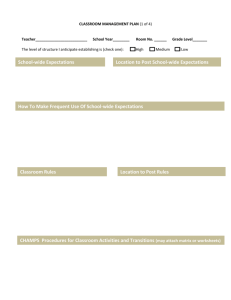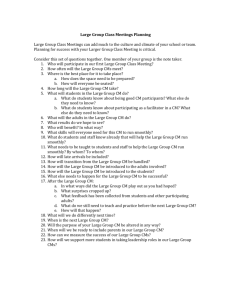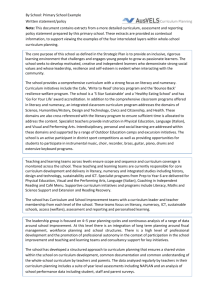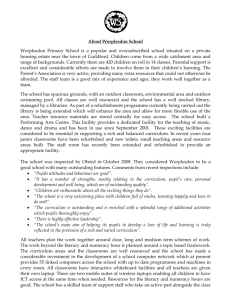Curriculum, teaching and learning audit 8 page profile
advertisement
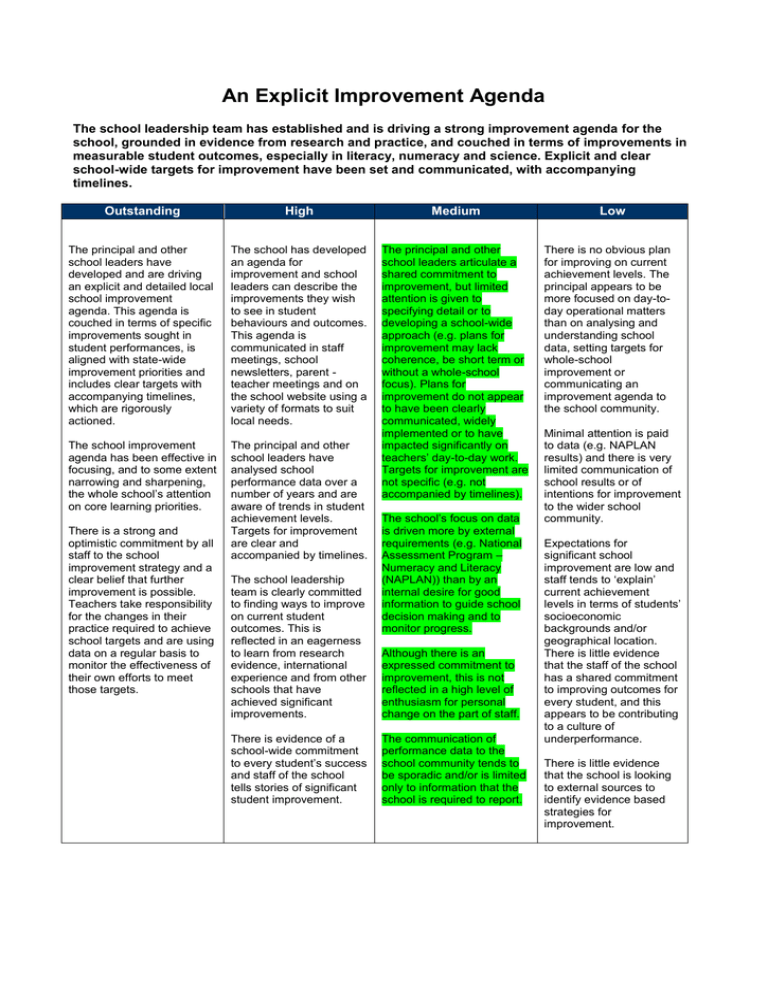
An Explicit Improvement Agenda The school leadership team has established and is driving a strong improvement agenda for the school, grounded in evidence from research and practice, and couched in terms of improvements in measurable student outcomes, especially in literacy, numeracy and science. Explicit and clear school-wide targets for improvement have been set and communicated, with accompanying timelines. Outstanding High Medium The principal and other school leaders have developed and are driving an explicit and detailed local school improvement agenda. This agenda is couched in terms of specific improvements sought in student performances, is aligned with state-wide improvement priorities and includes clear targets with accompanying timelines, which are rigorously actioned. The school has developed an agenda for improvement and school leaders can describe the improvements they wish to see in student behaviours and outcomes. This agenda is communicated in staff meetings, school newsletters, parent teacher meetings and on the school website using a variety of formats to suit local needs. The school improvement agenda has been effective in focusing, and to some extent narrowing and sharpening, the whole school’s attention on core learning priorities. The principal and other school leaders have analysed school performance data over a number of years and are aware of trends in student achievement levels. Targets for improvement are clear and accompanied by timelines. The principal and other school leaders articulate a shared commitment to improvement, but limited attention is given to specifying detail or to developing a school-wide approach (e.g. plans for improvement may lack coherence, be short term or without a whole-school focus). Plans for improvement do not appear to have been clearly communicated, widely implemented or to have impacted significantly on teachers’ day-to-day work. Targets for improvement are not specific (e.g. not accompanied by timelines). There is a strong and optimistic commitment by all staff to the school improvement strategy and a clear belief that further improvement is possible. Teachers take responsibility for the changes in their practice required to achieve school targets and are using data on a regular basis to monitor the effectiveness of their own efforts to meet those targets. The school leadership team is clearly committed to finding ways to improve on current student outcomes. This is reflected in an eagerness to learn from research evidence, international experience and from other schools that have achieved significant improvements. There is evidence of a school-wide commitment to every student’s success and staff of the school tells stories of significant student improvement. The school’s focus on data is driven more by external requirements (e.g. National Assessment Program – Numeracy and Literacy (NAPLAN)) than by an internal desire for good information to guide school decision making and to monitor progress. Although there is an expressed commitment to improvement, this is not reflected in a high level of enthusiasm for personal change on the part of staff. The communication of performance data to the school community tends to be sporadic and/or is limited only to information that the school is required to report. Low There is no obvious plan for improving on current achievement levels. The principal appears to be more focused on day-today operational matters than on analysing and understanding school data, setting targets for whole-school improvement or communicating an improvement agenda to the school community. Minimal attention is paid to data (e.g. NAPLAN results) and there is very limited communication of school results or of intentions for improvement to the wider school community. Expectations for significant school improvement are low and staff tends to ‘explain’ current achievement levels in terms of students’ socioeconomic backgrounds and/or geographical location. There is little evidence that the staff of the school has a shared commitment to improving outcomes for every student, and this appears to be contributing to a culture of underperformance. There is little evidence that the school is looking to external sources to identify evidence based strategies for improvement. Analysis and Discussion of Data A high priority is given to the school-wide analysis and discussion of systematically collected data on student outcomes, including academic, attendance and behavioural outcomes. Data analyses consider overall school performance as well as the performances of students from identified priority groups; evidence of improvement/regression over time; performances in comparison with similar schools; and, in the case of data from tests such as NAPLAN, measures of growth across the years of school. Outstanding High Medium Low The principal and other school leaders clearly articulate their belief that reliable data on student outcomes are crucial to the school’s improvement agenda. The school has established and is implementing a systematic plan for the collection, analysis and use of student achievement data. Test data in literacy, numeracy and science are key elements of this plan. There is evidence that the principal and other school leaders view reliable, timely student data as essential to their effective leadership of the school. There is a documented school plan and timetable for the annual collection of student outcome data. School leaders pay close attention to data provided to them about the performance of the school (e.g. NAPLAN results; Year 12 results) and identify areas in which the school is performing relatively poorly or well. There is very little evidence of school leaders’ practical use of school-wide student outcome data. There is either no annual data collection plan for the school or the plan is being implemented in a minimalist fashion. The school makes little or no use of tests beyond those that the school is required to use. Data are used throughout the school to identify gaps in student learning, to monitor improvement over time and to monitor growth across the years of school. A high priority has been given to professional development aimed at building teachers’ and leaders’ data literacy skills. Staff conversations and language reflect a sophisticated understanding of data concepts (e.g. valueadded; growth; improvement; statistical significance). Teachers are given test data (including NAPLAN) for their classes electronically and are provided with, and use, software (e.g. Excel) to analyse, display and communicate data on individual and class performances and progress, including comparisons of pre- and post-test results. Teachers routinely use objective data on student achievement as evidence of successful teaching. One or more members of staff have been assigned responsibility for implementing the annual plan, analysing the full range of school data, and summarising, displaying and communicating student outcome data for the school. The school has ensured that appropriate software is available and that the assigned staff have been trained to undertake data analyses (e.g. training in the use of the Corporate Data Warehouse, OneSchool). Time is set aside (e.g. on Pupil Free Days and in staff meetings) for the discussion of data and the implications of data for school policies and classroom practices. These discussions occur at whole-school and team levels. The school can illustrate through case studies, meeting minutes and project plans how data have been used to identify priorities, take action and monitor progress. Tests (e.g. commercially available reading tests) may be used by some teachers, but generally are not used as part of a whole-school assessment strategy. An ad hoc approach exists to building staff skills in the analysis, interpretation and use of classroom data. Software may be used for the analysis of school results, including the performances of priority groups, but analyses generally do not extend to studies of improvement or growth. School data are presented to staff in meetings, but presentations tend to be ‘for information’ rather than a trigger for in-depth discussions of teaching practices and school processes. Information about the school’s performance is communicated to the school community, but may lack explanation or analysis. Teachers do not systematically analyse test and other data for their classes and teachers make little use of data to reflect on their teaching. The school is unable to demonstrate how data have been used in meetings to analyse and discuss current achievement levels and strategies for improvement. A Culture That Promotes Learning The school is driven by a deep belief that every student is capable of successful learning. A high priority is given to building and maintaining positive and caring relationships between staff, students and parents. There is a strong collegial culture of mutual trust and support among teachers and school leaders. The school works to maintain a learning environment that is safe, respectful, tolerant, inclusive and that promotes intellectual rigour. Outstanding High Medium Low The school ethos is built around high expectations and a commitment to academic excellence. There is an expectation that every student will learn and achieve positive outcomes. Classrooms are calm but busy and interruptions to teaching time are kept to a minimum. There are no obvious behavioural problems and staff morale is high. There is a happy, optimistic feel to the school. The ‘tone’ of the school reflects a school-wide commitment to purposeful, successful learning. Classrooms are calm but busy and interruptions to teaching time are kept to a minimum. There are very few obvious behavioural problems and behaviour management takes up very little, if any, time of school leaders and classroom teachers. Classrooms are generally orderly, although some are more so than others. Nonattendance is an issue for a small minority of students. However, many other students appear to be minimally engaged in productive learning activities. Behavioural problems, disengagement and nonattendance are issues for a significant proportion of students. In a number of classrooms students are clearly not engaged in productive learning activities. High levels of trust are apparent across the school community. Interactions are focused on the learning and wellbeing of students and on continually improving the school’s ability to meet the needs of all students. Parents, school leaders and teachers work together in a mutually supportive way and there is a strong sense of belonging and pride in the school. A strong collegial culture has been established. Teachers have an overt and shared commitment to the improvement of teaching, and openness to critique by colleagues. This is reflected in the fact that teachers regularly invite leaders and colleagues to visit their classrooms to observe their teaching. There is a strong focus on quality learning and on the creation of a culture in which all students are expected to learn successfully, in their own ways and at their own pace. Individual talents are valued. Class ‘busy work’ is kept to a minimum, and an attempt is made to ensure that all students are engaged in challenging, meaningful learning. Respectful and caring relationships are reflected in the ways in which staff, students and parents interact and in the language they use in both formal and informal settings. Parents are encouraged to take a genuine and close interest in the work of the school and are welcomed as partners in their children’s learning. There are agreed guidelines on such matters as greeting visitors, taking messages, and responding to queries promptly and respectfully. Staff morale is generally high. The school effectively implements its Responsible Behaviour Plan for Students, for example, by ensuring that disruptive behaviour, bullying and harassment are dealt with promptly. The school has clear expectations for how students should behave and interact with one another, and in the main, relationships are caring and respectful. Some staff time is taken up dealing with behaviour problems. Most parents take an obvious interest in their children’s learning. Engagement is primarily through regularly scheduled parent-teacher interviews. Staff morale is satisfactory. The school may have a Responsible Behaviour Plan for Students but this appears to have had little impact on student behaviour. Much of the time of school leaders and teachers is taken up dealing with inappropriate behaviour. Interactions between parents, staff and students are not always productive and respectful. Some teachers appear to work in isolation from colleagues. Staff morale is low and staff turnover is high. Targeted Use of School Resources The school applies its resources (staff time, expertise, funds, facilities, materials) in a targeted manner to meet the learning needs of all students. It has school-wide policies, practices and programs in place to assist in identifying and addressing student needs. Flexible structures and processes enable the school to respond appropriately to the needs of individual learners. Outstanding High Medium Low The principal and other school leaders have given a very high priority to understanding and addressing the learning needs of all students in the school. This is reflected in the implementation of systematic strategies for identifying student needs and the development of creative school-wide solutions for addressing those needs. The principal and other school leaders have introduced programs and strategies to identify and address the needs of students in the school and are sourcing and applying available resources to meet those needs. The school uses its human and physical resources to address the needs of students, although this may not be preceded by a systematic analysis of those needs. The improvement of student outcomes does not appear to be the driving consideration in the allocation of school resources (e.g. the use of discretionary school funds). Specialist diagnostic testing is organised for a small number of students with special needs, but teachers do not routinely administer tests to better understand specific learning difficulties (e.g. problems in learning to read) or individual learning needs (e.g. LBOTE, gifted). There is very little, if any, systematic testing of students to identify individual learning needs. A school-wide process has been established for identifying specific student learning needs. This process includes systematic testing to establish learning gaps and special needs. Records of individual student needs, achievements and progress are maintained centrally and shared across year levels. A range of initiatives (e.g. across-class and acrossgrade groupings for literacy and numeracy; the sharing of specialist teachers with neighbouring schools) is being implemented to make more effective use of available resources to enhance teaching and learning. The school deploys staff in ways that make best use of their expertise (e.g. specialist reading/science teachers). The school has developed processes (e.g. systematic testing) for identifying student learning needs, although there may not always be good central records of student achievement and progress. Programs to meet individual learning needs (e.g. programs for gifted students, students with learning difficulties, students for whom English is a second language, Indigenous students, and refugees) are prioritised, where possible, in the school budget. Physical spaces and technology are used effectively to maximise student learning. Learning spaces are organised for whole group work, small group work and individual work. There are very few schoolwide programs or policies designed to address the learning needs of particular student groups (e.g. gifted students, students with disabilities, students for whom English is a second language). School leaders encourage teachers to address individual learning needs in classrooms, but there are very few agreed school wide strategies for doing this. Physical learning spaces are used creatively and technology is accessible to the majority of staff and students. The school does not always make best use of available staff expertise. School leaders have developed very few, if any, school-wide policies or programs to address individual needs, which are left to classroom teachers. School learning spaces tend to be used traditionally, with limited flexibility to support different kinds of learners and learning. An Expert Teaching Team The school has found ways to build a professional team of highly able teachers including teachers that take an active leadership role beyond the classroom. Strong procedures are in place to encourage a school-wide, shared responsibility for student learning and success, and to encourage the development of a culture of continuous professional improvement that includes classroombased learning, mentoring and coaching arrangements. Outstanding High Medium Low The teaching staff of the school are experts in the subjects they teach and have very high levels of pedagogical knowledge and skill, including expert knowledge of evidence based teaching strategies. There is evidence that the principal and other school leaders see the development of staff into an expert and coherent schoolwide teaching team as central to improving outcomes for all students. Teachers and school leaders take personal and collective responsibility for improving student learning, working as a team and learning from each other’s practices. In team meetings there is an emphasis on the joint analysis of student work and on teaching strategies for improving student learning. Teachers collaboratively plan, deliver and review the effectiveness of lessons. There is a documented professional learning plan and the school has arrangements in place for mentoring and coaching (with teacher agreement). Teachers visit each other’s classrooms and welcome opportunities to have principals and other school leaders observe and discuss their work with them. The school undertakes professional learning activities, although these may not always focus on the development of knowledge and skills required to improve student learning and there may not be a coherent, documented learning plan. The development of a professional school-wide team does not appear to be a driving consideration of the principal or other school leaders (eg, no reference is made to the Professional Standards for Teachers, there are no mentoring arrangements in place, teachers work largely in isolation from one another ‘behind closed doors’). School leaders place a very high priority on the ongoing professional learning of all staff and on the development of a schoolwide, self-reflective culture focused on improving classroom teaching School leaders participate in professional learning activities, learning alongside teachers, and the school supports teachers to continue formal study and celebrates professional success. Attention is paid to strengths and weaknesses in the school-wide team, with strategies in place, in conjunction with Regional Office, to recruit staff with particular expertise, to train staff to address particular needs, and to support staff that find it difficult to commit to the school’s improvement agenda. The school provides opportunities for teachers to take on leadership roles outside the classroom. The principal and leadership team are seen as supportive of, but not generally involved in, the day-to-day practice and learning of teachers. Teachers are open to constructive feedback and provide feedback to colleagues, although there may not be formal mentoring and coaching arrangements in place. The school is implementing the Department’s Developing Performance Framework as the basis for professional discussions with staff. The school’s professional learning agenda is made explicit to staff at induction, and in staff handbooks. Where a managing unsatisfactory performance process is required, it is performed professionally and effectively, and in accordance with the agreed Departmental guidelines. There is little evidence that school leaders are proactive in the recruitment and retention of staff. There is little sense of a whole-school coordinated approach to professional learning and a low priority is given to the Department’s Developing Performance Framework. Systematic Curriculum Delivery The school has a coherent, sequenced plan for curriculum delivery that ensures consistent teaching and learning expectations and a clear reference for monitoring learning across the year levels. The plan, within which evidence-based teaching practices are embedded, and to which assessment and reporting procedures are aligned, has been developed and refined collaboratively to provide a shared vision for curriculum practice. This plan is shared with parents and caregivers. Outstanding High Medium The school has a clearly documented whole school plan for curriculum delivery. This plan is aligned with the Queensland Curriculum Assessment and Reporting (QCAR) framework and makes explicit what (and when) teachers should teach and students should learn. The curriculum delivery plan is being implemented throughout the school. The school’s curriculum delivery plan identifies the curriculum, teaching and learning priorities and requirements set out in the P-12 Curriculum Framework. The curriculum delivery plan reflects a shared vision (principal, school leadership team, and teachers) for the school, and provides a context for delivering the required curriculum as detailed in the QCAR Framework. The school has a documented plan for curriculum delivery that includes year level and term plans, as specified in the Department’s ‘Roadmap’, but the progression of learning from year to year is not always obvious and the relationship between the pieces of the plan (the year, term and unit plans) would benefit from further clarification. School leaders and teachers do not appear to be familiar with the ‘Roadmap’ or the documents to which the ‘Roadmap’ refers. School leaders talk about embedding the fundamental skills of literacy, numeracy and higher order thinking within all KLAs, but there is little evidence that schoolwide strategies are in place to drive a consistent approach. Literacy tends to be seen as the responsibility of English teachers and numeracy the responsibility of mathematics teachers. The enacted school curriculum is not seen as a central concern of all teachers (e.g. it is not a regular topic of conversation, a focus for assessment design or a framework against which student learning is reported). A strong alignment has been achieved between the overall curriculum delivery plan, term and unit plans, classroom teaching and the regular assessment of student progress in relation to curriculum expectations. Considerable attention has been given to ensuring ‘vertical’ alignment of the curriculum so that there is continuity and progression of learning across the years of school, with teaching in each year building on to and extending learning in previous years. The school curriculum plan and curriculum delivery (including the time allocated to particular learning) balances the system requirements to address all KLAs in the QCAR Essential Learnings, to give priority to English, mathematics and science and to embed the fundamental skills of literacy, numeracy and higher order thinking within all KLAs. The school leadership team ensures that the enacted curriculum remains a focus for discussion among, and collaboration between, teachers and that the curriculum plan is the reference against which flexible delivery (to meet the needs of the range of students within each year level) is designed, assessment tasks are developed and student learning is reported. Discussions about curriculum delivery tend to be sporadic and reactive with a year level focus rather than being driven by a leadership team with a whole school approach. The parameters detailed in the ‘Roadmap’ and the documents referred to in the ‘Roadmap’ are rarely mentioned. Low The school may have a documented plan for curriculum delivery but there is little evidence that the whole school plan drives the lesson plans of individual teachers. Differentiated Classroom Learning In their day-to-day teaching, classroom teachers place a high priority on identifying and addressing the learning needs of individual students. Teachers closely monitor the progress of individuals, identify learning difficulties and tailor classroom activities to levels of readiness and need. Outstanding High Medium Low The principal and other school leaders actively promote the use of differentiated teaching as a strategy for ensuring that every student is engaged and learning successfully. It is recognised throughout the school that some students require significant adjustments to their learning programs (e.g. accelerated programs, special support) if they are to be optimally engaged and challenged, and individual learning plans have been developed for a least some students. Differentiation is a priority of the school and a feature of every teacher’s practice. School leaders explicitly encourage teachers to tailor their teaching to student needs and readiness. This includes the systematic use of assessment instruments (standardised assessment tasks and teacher developed assessment tools) to establish where individuals are up to in their learning and to identify skill gaps and misunderstandings. Teachers also are encouraged to respond to differences in cultural knowledge and experiences and to cater for individual differences by offering multiple means of representation, engagement and expression. School leaders are committed to success for all, but do not drive a strong classroom agenda to assess and identify individual learning needs or to differentiate teaching according to students’ needs. School leaders do not place a high priority on teachers identifying and addressing individual learning needs, but are more focused on ensuring that all teachers are teaching the core year level curriculum. Regular data on the achievements, progress, strengths and weaknesses of individual students are used in all classrooms to make judgements about individual needs, to identify appropriate starting points for teaching and to personalise teaching and learning activities. Planning shows how the different needs of students are addressed, and how multiple opportunities to learn are provided including multiple pathways for transition to external studies (e.g. apprenticeships) for students in Years 10-12. Students’ workbooks also illustrate differentiated tasks and feedback. Reports to parents show progress over time and include suggestions for ways in which parents can support their children’s learning. Some use is made of assessment instruments to identify individual strengths and weaknesses and starting points for teaching, but this appears to be at the initiative of individual teachers rather than a school-wide expectation. Some use is made of differentiated teaching (e.g. differentiated reading groups in the early primary years), but in most classes teachers teach the same curriculum to all students with similar levels of individual support. Regular assessments of student learning are undertaken, but these often are summative and disconnected (e.g. relating to different topics) rather than exploring progress in skill development and understanding over time. Reports to parents generally do not show progress over time or provide guidance to parents on actions they might take. Little or no classroom use is made of assessment instruments to establish starting points for teaching. Assessments tend to be used only to establish summatively how much of the taught content students have learnt. Teachers tend to teach to the middle of the class, with the expectation that some students will not master the content, and finding ways to occupy more able students who finish work early. Reports to parents tend to be summative reports of how students have performed, with little guidance on what parents might do to assist in their children’s learning. Effective Teaching Practices The school principal and other school leaders recognise that highly effective teaching practices are the key to improving student learning throughout the school. They take a strong leadership role, encouraging the use of research-based teaching practices in all classrooms to ensure that every student is engaged, challenged and learning successfully. All teachers understand and use effective teaching methods, including explicit instruction, to maximise student learning. Outstanding High Medium Low The principal and other school leaders have accepted personal responsibility for driving improvements in teaching throughout the school. They demonstrate a strong conviction that improved teaching is the key to improved student learning and have clear and wellknown positions on the kinds of teaching that they wish to see occurring. School leaders are committed to continuous improvement in teaching practices throughout the school and expect team leaders and teachers to identify ways of doing this, although the principal and other senior leaders may not themselves have clear positions on the kinds of teaching they wish to see occurring across the school or be ‘hands on’ in driving improved teaching practices. School leaders are explicit about their desire to see effective teaching occurring throughout the school, but are less clear about what this might look like. They do not appear to be driving a strong agenda to improve and/or enhance teaching practices across the school, except perhaps indirectly through a focus on school results and targets. School leaders take a close interest in the school’s literacy and numeracy results, but generally do not engage in discussions with staff about effective literacy and numeracy teaching strategies. School leaders do not appear to have strong views on the characteristics of highly effective teaching. There is little evidence that they are driving an agenda to change or enhance teaching practices across the school. Discussions of specific teaching practices are rare and generally occur only in the context of concerns about a teacher’s performance. There may be a lack of explicitness about what students are expected to know and be able to do as a result of classroom activities, very little explicit teaching, limited attention to individual learning needs, or low expectations on the part of teachers that all students in the room will master the content of lessons. Classroom activities frequently have the appearance of ‘busy work’. All teachers and leaders are committed to identifying and implementing better teaching methods, and a high priority is given to evidence-based teaching strategies (strategies that have been demonstrated through research and practice to be highly effective). School leaders spend time working with teachers to improve their teaching practices, including modelling, evaluating and providing feedback on classroom teaching. There is a particular focus on improved teaching methods in reading, writing, mathematics and science, and professional learning activities are focused on building teachers’ understandings of highly effective teaching strategies in these areas. Clarity about what students are expected to learn and be able to do, high expectations of every student’s learning, explicit teaching of skills and content, individualised attention as required, and timely feedback to guide student action are key elements of the school’s push for improved teaching and learning. There is some clarity about what students are expected to learn, but a lack of balance in teaching methods (eg, over-reliance on whole-group teaching or very little explicit teaching). The principal and other school leaders spend very little time on issues related to teaching. Questions of pedagogy appear to be viewed solely as the responsibility of teachers. There is little obvious school-wide discussion or consideration of highly effective teaching methods.

